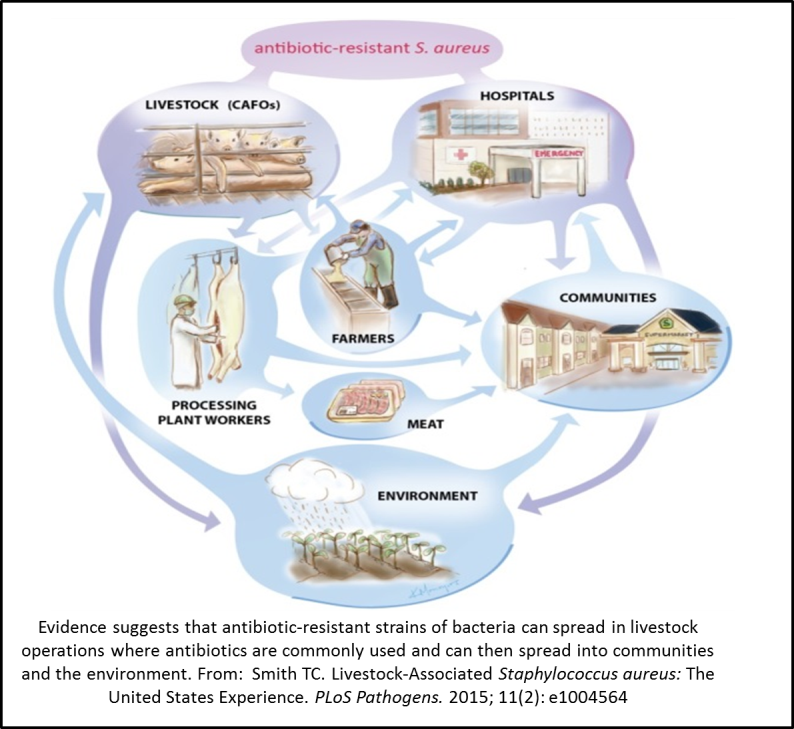


Sign-up for {N}power to get exclusive discounts, newsletters, members-only features, and more!

I first heard the term “antibiotic resistance” almost a decade ago in a microbiology class. At the time, my professor talked about the overuse and improper use of antibiotics for viral infections or non-serious cases of the common cold and how this was contributing to the growing problem of antibiotic resistant bacteria.[fn value=1][/fn] I filed that tidbit of information away and continued studying for my finals.
And then 5 years later, a 2011 a study published in the Journal of Clinical Infectious Diseases surprised and confused me. This paper showed that multidrug resistant Staphylococcus aureus (MSRA) was more than present in the meat and poultry sold in the United States, it was very common. In fact, 77% of the turkey samples that were examined tested positive for MRSA.[fn value=2][/fn]At the time, I was confused by this observation because I didn’t understand how MRSA, a dangerous type of antibiotic resistant bacteria found in hospitals, could be found on meat and poultry products sold in conventional grocery stores across the country. What I did know was that improper use of antibiotics leads to the creation of antibiotic resistant bacteria, but I still didn’t quite understand why they were showing up on meat and poultry.
Maybe that is because at the time, I didn’t know that 70-80% of the antibiotics made in this country were actually put into animal feed.[fn value=3][/fn] I didn’t know that much of the meat sold in conventional grocery stores comes from animals housed in dirty confined animal feeding operations (CAFOs). It is in these CAFOs that animals require the continuous feeding of subtherapeutic doses of antibiotics in order to keep them growing. This continuous feeding of subtherapeutic doses of antibiotics is absolutely contributing to the growing problem of the development of antibiotic resistance in bacteria.
The growth of antibiotic resistance in bacteria has been on the public health radar for quite some time. Numerous doctors and other public health organizations have called for more robust “antimicrobial stewardship,” and the World Health Organization published data showing that in the last decade infections from antibiotic resistant bacteria have killed more people worldwide than traffic accidents, HIV and influenza.[fn value=4][/fn] Each year in the United States tens of thousands of people die from antibiotic resistant bacterial infections.[fn value=5][/fn]
Despite the notable and well accepted science showing that feeding animals subtherapeutic doses of antibiotics leads to the development of antibiotic resistance, [fn value=6][/fn] [fn value=7][/fn] the majority of the meat and poultry produced in this country is still produced in this fashion; therefore, there is a good chance your conventional Thanksgiving turkey was raised with antibiotics. Antibiotic resistant bacteria created from raising animals with antibiotics are then dispersed throughout the environment and community (see the figure below), sickening and killing many people.[fn value=8][/fn] However…there is growing consumer awareness around this issue – people want safer, healthier food – and luckily there are really great farmers who are doing things the right way and not raising animals in CAFOs and not using antimicrobials in the production of their poultry.
And that is why we are proud to carry “Mary’s Turkeys” here at Natural Grocers. Mary’s actually raises all sorts of poultry (ducks, geese, turkeys, and chickens), all without the use of antibiotics or other growth promoters commonly used in the industry.

Yep, that’s right, in conventional turkey production, not only are subtherapeutic doses of antibiotics added to the feed, but other growth promoting drugs such as arsenic-based growth promoters and beta-adrenergic agonists (a type of asthma medicine) are also commonly incorporated into turkey feed.[fn value=9][/fn] These drugs have both been shown to accumulate in the meat of animals fed them and are illegal in many countries.[fn value=10][/fn]One study published by a group of researchers at Johns Hopkins University found that feeding poultry with an arsenic-based growth promoter called roxarsone resulted in detectable and dangerous levels of arsenic in poultry meat.[fn value=11][/fn] Poisoning has been reported in numerous countries after consuming meat raised with ractopamine, a beta-adrenergic agonist.[fn value=12][/fn]In fact, here is the warning label from a type of turkey feed containing ractopamine, a beta-adrenergic agonist allowed in the United States for animal production:
“WARNING: The active ingredient in Topmax, ractopamine hydrochloride, is a beta-adrenergic agonist. Individuals with cardiovascular disease should exercise special caution to avoid exposure. Not for use in humans. Keep out of the reach of children. The Topmax 9 formulation (Type A Medicated Article) poses a low dust potential under usual conditions of handling and mixing. When mixing and handling Topmax, use protective clothing, impervious gloves, protective eye wear, and a NIOSH-approved dust mask. Operators should wash thoroughly with soap and water after handling. If accidental eye contact occurs, immediately rinse eyes thoroughly with water. If irritation persists, seek medical attention. The material safety data sheet contains more detailed occupational safety information. To report adverse effects, access medical information, or obtain additional product information, call 1-800-428-4441.”
Sounds like a great thing to feed to animals, doesn’t it?
It can be a little hard to talk about these things without seemingly painting a sad and scary picture of the meat industry. What should be pointed out and applauded is that not everyone is doing things this way. I hope that this blog has served as a guide to why Mary’s Turkeys truly are different from the norm. They are raised on non-GMO vegetarian feed, given room to roam, and never given any growth promoters or fed antibiotics. As one of my colleagues likes to remind me — we are in the middle of a food revolution — and Americans want to know where their food comes from and how it was produced. What could be a better time to celebrate the highest quality food than at Thanksgiving with a turkey that we here at Natural Grocers are proud to serve to our own families? Happy Thanksgiving!



Sign-up for {N}power to get exclusive discounts, newsletters, members-only features, and more!